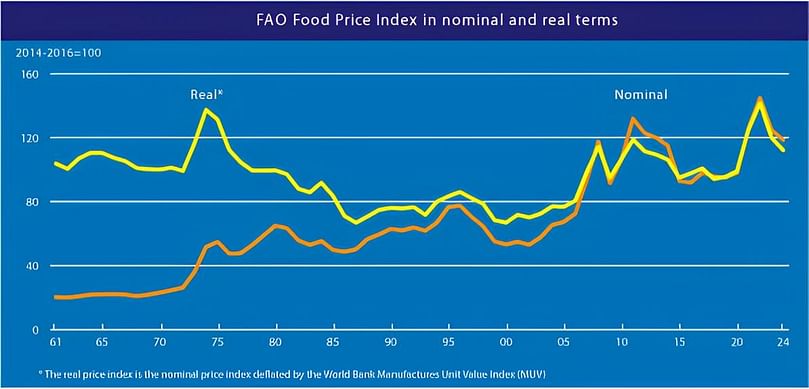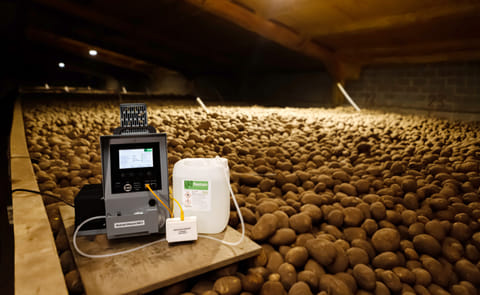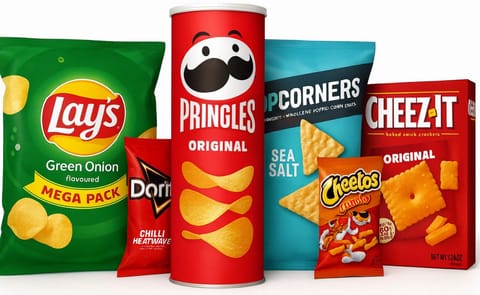FAO Food Price Index slightly up in May: higher cereal and dairy prices offset easing sugar and vegetable oil quotations
FAO Food Price Index slightly up in May: higher cereal and dairy prices offset easing sugar and vegetable oil quotations

The FAO Food Price Index* (FFPI) stood at 120.4 points in May 2024, up 1.1 points (0.9 percent) from its revised April level, as increases in the price indices for cereals and dairy products slightly more than offset decreases in those for sugar and vegetable oils, while the meat price index was almost unchanged.
Although it registered a third consecutive monthly uptick in May, the FFPI remained down 3.4 percent from its corresponding value one year ago and 24.9 percent below the peak of 160.2 points reached in March 2022.
The FAO Cereal Price Index averaged 118.7 points in May, up 7.1 points (6.3 percent) from April, but still 10.6 points (8.2 percent) below its May 2023 value.
Global export prices of all major cereals rose month-on-month, with wheat prices increasing the most. The sharp monthly rise was largely due to growing concerns about unfavourable crop conditions for the 2024 harvests, possibly constraining yields in some main producing areas of several major exporting countries, including in parts of Europe, Northern America and the Black Sea region. Additionally, damage to the Black Sea shipping infrastructure exacerbated the upward pressure on prices.
Maize export prices also increased in May, reflecting production concerns in both Argentina (due to crop damage from the spread of Spiroplasma disease) and Brazil (due to unfavourable weather), along with limited farmer selling activity in Ukraine amidst seasonally tightening supplies and a strong global demand.
Spillover effects from the wheat markets also affected maize prices. For other coarse grains, world prices of barley and sorghum also rose in May. The FAO All Rice Price Index edged up by 1.3 percent in May, driven by higher Indica quotations, influenced by expectations of sales to Indonesia and Brazil, and easing harvest pressure.
The FAO Vegetable Oil Price Indexaveraged 127.8 points in May, down 3.1 points (2.4 percent) month-on-month, yet standing 7.7 percent above its year-earlier level.
The index decrease was mostly driven by lower palm oil quotations, more than offsetting higher soy, rapeseed and sunflower oil prices. International palm oil prices declined for the second consecutive month in May, as outputs across major producing countries in Southeast Asia seasonally increased amid a protracted weak global import demand.
By contrast, world soyoil prices rebounded in May, broadly underpinned by increasing demand from the biofuel sector, particularly in Brazil. Meanwhile, sunflower and rapeseed oil prices also firmed, mainly reflecting, respectively, seasonally diminishing export availabilities in the Black Sea region and the likelihood of tightening supplies in the upcoming 2024/25 season.
The FAO Dairy Price Indexaveraged 126.0 points in May, up 2.3 points (1.8 percent) from April, pushing the index value 4.3 points (3.5 percent) above its corresponding value a year ago.
International price quotations for all the dairy products represented in the index rose in May. Increased demand from the retail and food services sectors ahead of the summer holidays and market expectations that milk production may fall below historical levels in Western Europe, coupled with seasonally softening milk production in Oceania, underpinned the increase in dairy price quotations in May.
In addition, renewed import demand for spot supplies, especially from some countries in the Near East and Northern Africa, contributed to the increase in dairy prices.
Unlike for other commodity groups, most prices utilized in the calculation of the FAO Meat Price Index are not available when the FAO Food Price Index is computed and published; therefore, the value of the Meat Price Index for the most recent months is derived from a mixture of projected and observed prices. This can, at times, require significant revisions in the final value of the FAO Meat Price Index which could in turn influence the value of the FAO Food Price Index.

FAO Food Price Index in nominal and real terms











